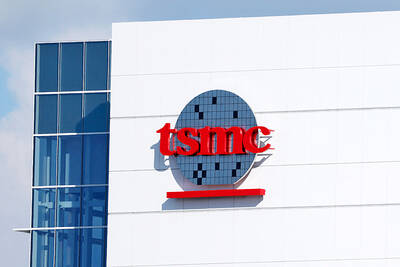Over the past two months, about 1,000 part-time workers for DBS Group Holdings Ltd have fanned out across Singapore’s famed food courts, trying to entice mom-and-pop hawkers to use the bank’s digital payments service, called PayLah.
“Hawkers need speed and they are afraid that using PayLah may not be fast enough when the queues are very, very long,” 19-year-old Erica Chiang, who has signed up 50 food vendors in her seven weeks working for DBS, said on a sweltering Wednesday afternoon. “Once they know the product, they become interested.”
Chiang is on the front lines of a push consuming banks across Southeast Asia these days: defending against Jack Ma’s (馬雲) Alibaba Group Holding Ltd (阿里巴巴) and its payments affiliate, Ant Financial Services Group (螞蟻金服), which are targeting the region as a major growth market.

Photo: Bloomberg
Southeast Asia’s banks have long been spared the competitive onslaught that saw their peers in China cede that nation’s giant payments market to Ant Financial and Tencent Holdings Ltd (騰訊). That is about to change, as Ma lines up partnerships across the region to win over some of the estimated 450 million people with limited access to banking services — and then use that position to go after the lenders’ core customers.
“We view the ‘big techs’ with large platforms as the ones we should be more concerned with,” DBS head of digital banking Sandeep Lal said.
Underscoring the perceived threat, the Singaporean government on Tuesday proposed new rules to make it easier for banks to invest in non-financial businesses, including e-commerce and digital-payment platforms.
In announcing the move, Singaporean Minister of Finance Heng Swee Keat (王瑞傑) cited “increasing competition from online and non-financial players.”
Digital payments in Southeast Asia, home to about 630 million people, might reach US$62.3 billion this year, according to the research firm Statista Inc.
The transition to digital offerings will put pressure on other lucrative areas for banks, like cross-border transactions, said James Lloyd, a Hong Kong-based financial technology specialist at consultancy EY.
“Banks will not be making the same profit margins in this market in five years,” Lloyd said.
China stands as a looming reminder of what happens when banks do not respond quickly enough. Alipay (支付寶) and an offering from Tencent carved up more than 90 percent of the country’s US$5.5 trillion mobile payments market between them in just four years.
Ant Financial has set up partnerships in Thailand, Indonesia and the Philippines to offer services like lending and money transfers. Together with Alibaba, it is also piecing together a digital payments business in heavily-banked Singapore.
Ant Financial’s tie-up with Ascend Money Co, a unit of Bangkok-based retail and telecoms conglomerate Charoen Pokphand Group, illustrates its approach.
Charoen Pokphand runs the 7-Eleven franchise in Thailand, which has almost 10,000 outlets across the country. Thais can sign up for Ascend Money’s product — known locally as TrueMoney — in 7-Eleven outlets and use it to pay for online shopping or at a range of stores, even if they do not have regular bank accounts. They can top up their TrueMoney accounts in 7-Elevens with cash.
Ascend says it has more than 20 million users across Southeast Asia, mostly in Thailand.
“We start by serving the under-served, unserved customers, similar to in China,” said Douglas Feagin, the former Goldman Sachs Group Inc partner who now oversees Ant Financial’s international operations. “Then we look to expand that to a much broader customer base.”
Ma, through Alibaba and Ant Financial, is also stitching together an e-commerce and payments network in Singapore through the acquisitions of Lazada Group SA, online grocer RedMart Ltd and HelloPay, a mobile payments service now rebranded as Alipay.
Lazada, involved in payments, e-commerce, transport and storage, on Wednesday said Alibaba will invest another US$1 billion in the company to boost its stake to 83 percent.
DBS is moving to stave off the challenge by linking up with traditionally cash-heavy businesses. The bank is working with ComfortDelGro Corp, Singapore’s largest taxi firm, to equip 16,300 of its cabs with terminals that allow payments through PayLah by the third quarter of this year.
Other Southeast Asian banks are making similar pushes into digital services by introducing so-called e-wallet and payments options via mobile phones.
Malayan Banking Bhd, Malaysia’s largest lender, has introduced an e-wallet that allows clients to send money gifts on special occasions.
In Thailand, Kasikornbank Pcl has set aside 5 billion baht (US$147 million) per year for investment in digital-banking technology.
“If we don’t do anything, we believe there could be an impact to our business and revenue,” Maybank chief strategy officer Michael Foong Seong Yew said.

Real estate agent and property developer JSL Construction & Development Co (愛山林) led the average compensation rankings among companies listed on the Taiwan Stock Exchange (TWSE) last year, while contract chipmaker Taiwan Semiconductor Manufacturing Co (TSMC, 台積電) finished 14th. JSL Construction paid its employees total average compensation of NT$4.78 million (US$159,701), down 13.5 percent from a year earlier, but still ahead of the most profitable listed tech giants, including TSMC, TWSE data showed. Last year, the average compensation (which includes salary, overtime, bonuses and allowances) paid by TSMC rose 21.6 percent to reach about NT$3.33 million, lifting its ranking by 10 notches

Popular vape brands such as Geek Bar might get more expensive in the US — if you can find them at all. Shipments of vapes from China to the US ground to a near halt last month from a year ago, official data showed, hit by US President Donald Trump’s tariffs and a crackdown on unauthorized e-cigarettes in the world’s biggest market for smoking alternatives. That includes Geek Bar, a brand of flavored vapes that is not authorized to sell in the US, but which had been widely available due to porous import controls. One retailer, who asked not to be named, because

SEASONAL WEAKNESS: The combined revenue of the top 10 foundries fell 5.4%, but rush orders and China’s subsidies partially offset slowing demand Taiwan Semiconductor Manufacturing Co (TSMC, 台積電) further solidified its dominance in the global wafer foundry business in the first quarter of this year, remaining far ahead of its closest rival, Samsung Electronics Co, TrendForce Corp (集邦科技) said yesterday. TSMC posted US$25.52 billion in sales in the January-to-March period, down 5 percent from the previous quarter, but its market share rose from 67.1 percent the previous quarter to 67.6 percent, TrendForce said in a report. While smartphone-related wafer shipments declined in the first quarter due to seasonal factors, solid demand for artificial intelligence (AI) and high-performance computing (HPC) devices and urgent TV-related orders

MINERAL DIPLOMACY: The Chinese commerce ministry said it approved applications for the export of rare earths in a move that could help ease US-China trade tensions Chinese Vice Premier He Lifeng (何立峰) is today to meet a US delegation for talks in the UK, Beijing announced on Saturday amid a fragile truce in the trade dispute between the two powers. He is to visit the UK from yesterday to Friday at the invitation of the British government, the Chinese Ministry of Foreign Affairs said in a statement. He and US representatives are to cochair the first meeting of the US-China economic and trade consultation mechanism, it said. US President Donald Trump on Friday announced that a new round of trade talks with China would start in London beginning today,